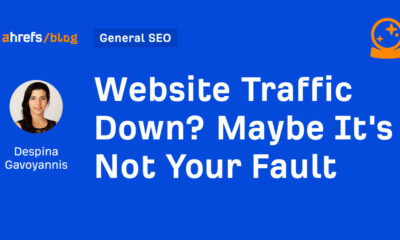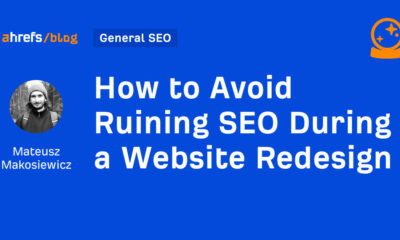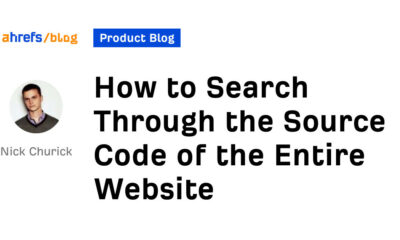SEO
Getting Started With Multilingual Website Tags
Often, the best practices of SEO don’t give us a direct ranking signal boost from Google, although they help drive significant traffic to our website.
Herflang tags are a perfect example of this.
While Gary Illyes has stated that hreflang tags don’t serve as a ranking signal in the algorithmic sense, in a cluster, a group of similar content pages in different languages share the same ranking authority.
In our pursuit of optimizing user intent and experience, writing content for different geographic locations and languages provides tremendous value to our website.
That’s where the magic of the hreflang tag comes in.
Rather than having the same webpage competing for users in Australia and France, you could have alternate pages that pop up at the top of SERPs optimized for that country’s language, currency, and privacy laws.
However, hreflang tags are one of the most complicated parts of technical SEO.
Unfortunately, you could do a lot more harm than good by improperly implementing this tag attribute across your website.
That’s why I want to provide this refresher course on everything you need to know about hreflang tags and the best practices to get started with international SEO using these incredibly granular tags.
What Is An Hreflang Tag?
Hreflang tags are a link tag attribute in HTML that enables websites to serve content specifically for users in different countries and languages.
If you view the page source of any given web document, the first tag you’ll often see is this:
<html lang=”en”>
The language attribute specifies this webpage employs English text for an English-speaking audience over search.
However, if a website wanted to target French-speaking users in France, they could use an hreflang attribute in the head of their HTML, which would look something like this:
<link rel=”alternate” href=”https://fr.example.com” hreflang=”fr-fr” />
Let’s break this down for easier understanding.
Basically, an hreflang string consists of three critical components:
- rel=alternate attribute: This tag specifies this webpage is an alternate version of the original web page, not the canonical.
- href= attribute: This tells Google the original URL of the alternate web page.
- hreflang= attribute: This tag specifies the language and country this web page is targeting.
In the above example, the alternate tag specified that URL https://fr.example.com was the primary English web page’s alternate.
In addition, the end of the tag also specified that the webpage was for French speakers in France.
In addition, webmasters could also create an alternate page for English speakers in France by adjusting the hreflang attribute to hreflang=”en-fr” which means this page is for English speakers in France.
Thorough hreflang implementation allows you to become more granular with geotargeting and serve up local content to people all across the globe.
What’s not to love from an SEO or content marketing perspective?
Why You Need Hreflang Tags
We can do more with hreflang tags than optimize for different languages.
In fact, hreflang tags enable us to do three critical things with our website:
- Optimize webpages for the same language in the same country (Ex. “fr-fr”).
- Optimize webpages for different languages in that same country (Ex. “de-fr”).
- Optimize webpages for different languages in different countries (Ex. “de-us”).
But why not just create broad English web pages for people in the UK and across the world?
Well, creating alternate web pages for English users in the UK and elsewhere enables customers overseas to purchase products on your website in pounds and localizes content specifically for their interests.
Furthermore, creating clusters of content also accumulates more SEO value for our website and web pages as a whole.
Another benefit of hreflang tags is that website owners can create specific web pages that conform to international laws and tax codes to avoid legal trouble.
Ultimately, proper hreflang tags benefit your website in many key ways, including:
- Localizing content for users across the globe.
- Gaining access to global markets.
- Allowing users to pay in native currencies.
- Preventing alternate web pages from competing with each other.
- Keeping websites organized.
At this point, I bet that hreflang tags sound like all peaches and cream for your web strategy.
Now, here comes the hard part: Setting up your tags.
I’ll walk you through several different strategies, so you have a solid understanding of how tags work in practice and how to implement them on your website.
First, let’s discuss some of the challenges you’ll encounter along the way if you are new to using hreflang tags.
Common Challenges Setting Up Hreflang Tags
Avoiding Duplicate Content
Improper hreflang tag implementation will result in duplicate content errors.
While Google doesn’t directly punish duplicate content, you don’t want an English page designed for Americans outranking a page meant for English speakers in France.
Segmenting Content Between Different Language And Country Codes
Hreflang tags require time, money, and commitment to properly organize each web page for a specific language and country.
You’ll also need to look up every country and language’s specific HTML codes.
Keeping Hreflang Tags Organized As You Add New Content
This challenge only compounds as you continue to add more content to your site.
Again, think of large-scale ecommerce sites and what they go through daily trying to add new products for customers across the globe.
Hreflang Tags Are Not A Directive
Unfortunately, hreflang tags are not an absolute directive. Mostly, hreflang tags serve as a hint for Google or Yandex to prioritize certain content, but nothing is guaranteed.
Hreflang Tags Work Differently Between Google And Bing
Search engines like Bing barely even look at these tags.
Instead, Bing uses meta tags like the <html lang=”en”> tag, which I showed in the beginning to organize and display content.
Hreflang Principles
We need to understand the relationship between different web pages and HTML to get started.
When implementing hreflang attributes, we want to remember two principles:
Hreflang Tags Need To Be Self-referential
In the past, Google has recommended that every webpage have a self-referential hreflang tag that points back to the original.
For example say your original URL is https://example.com/us. Then your hreflang attributes will be ordered like so:
<link rel=”alternate” href=”https://example.com/fr” hreflang=”fr” />
<link rel=”alternate” href=”https://example.com/us” hreflang=”en” />
So for every alternate webpage you create, you must never forget to include a link attribute for that webpage.
For example, a French webpage should have an href attribute for the French URL.
It may feel a tad redundant, but it cuts down on confusion from Google’s end and helps avoid duplicate content errors.
Hreflang Tags Need To Be Bi-directional
This second principle is absolutely required and will eliminate any lost SEO value from clustering your web pages and transferring those awesome metrics between the two.
So let’s take the above example and say that the homepage has an alternate version translated into French for French visitors from France.
We need to implement a tag on the French page that points back to the main U.S. page and self-references itself.
It’s not as confusing as it sounds! Simply just swap them around like this:
<link rel=”alternate” href=”https://example.com/us” hreflang=”en” />
<link rel=”alternate” href=”https://example.com/fr” hreflang=”fr” />
If you have dozens of different languages and countries, don’t sweat.
All you need to do is have the original URL listed as self-referencing at the bottom and ensure that every page has tags set up for every language and region, not just your original English page.
Bonus
I also recommend using an X-default page for situations when Google can’t extract their language or region from a user’s browser or IP address.
An x-default page asks visitors what language they prefer and sends them to the appropriate alternate page. The tag will look something like this:
<link rel=”alternate” hreflang=”x-default” href=”https://example.com/” />
Now that we know how the HTML code works and how to set them up, we just need to learn how to set hreflang tags up.
Setting Up Hreflang Tags
You generally have three great options available to set up hreflang tags and implement them at scale.
HTML/HTTP Headers
Setting up HTML tags is the simplest but most time-consuming method. I recommend this for websites without a sitemap, although you should definitely invest in a sitemap, especially if you have a ton of content or products!
Going through what we’ve discussed so far, set a <link> tag to the alternate version of your page in the header of the HTML to look something like this:
<link rel=”alternate” hreflang=”en-us” href=”https://example.com/home” />
From there, make sure each tag is self-referential and bi-directional.
In addition, if you want to create alternate pages for .pdf files without HTML, you’ll need to implement the same tags in the HTTP header of each page.
Fortunately, the link will look the same and you can apply the same rules for easy implementation.
Of course, you can see how hard this can be to scale, especially if you serve customers in dozens of countries in dozens of languages.
Generally, changing the HTML or HTTP is fine when you need to adjust a few pages over time, but this method won’t serve you well in the long run if you’re dealing with thousands of URLs.
XML Sitemap
I recommend using your XML sitemap to implement all of your tags in a single file and optimize your website at scale.
This method is pretty straightforward.
All you need to do is add <xhtml:link to the front of your URL and add all alternative versions of the page underneath.
<url>
<loc>https://example.com/link</loc>
<xhtml:link rel=”alternate” hreflang=”en-us” href=”x-default”
<xhtml:link rel=”alternate” hreflang=”en” href=”https://example.com/link/” />
<xhtml:link rel=”alternate” hreflang=”fr” href=”https://example.com/lien/” />
Using this method, you can add all of your relevant tags in one file instead of manually adding link attributes to the HTML of every webpage.
Once completed, submit an updated sitemap to Google Search Console.
Of course, there are several ways to automate this process by using a spreadsheet to copy and paste all of your URLs from a sitemap under separate languages and regions.
There are also several hreflang generation tools available online, although I’d recommend doing your research before you end up causing more harm than good to your website.
Common Mistakes Setting Up Hreflang Tags
Based on how meticulous hreflang tags can be, you’ll likely run into several issues during setup. As a result, many of these mistakes will spell duplicate content in the eyes of Google and sour your rankings. Don’t worry because the solutions are pretty straightforward.
Not Making Hreflang Tags Self-Referential
A missing hreflang self-referencing attribute can be holding back one of your pages from ranking.
Fortunately, multiple site audit tools, including Screaming Frog, SEMrush, and Ahrefs, check for proper hreflang implementation, including self-referencing attributes.
Scan for pages missing this attribute and fix issues in real-time.
No Return Tag
Additionally, it’s easy to violate our second principle of hreflang tags by failing to employ bi-directional tags.
You can spot this error in the International Targeting and Language tab in Google Search Console.
Simply go into your sitemap or adjust the header tag of your webpage to link back to the original or canonical webpage.
Incomplete Or Improper Tags
This issue could arise for several reasons, including human error or your hreflang generator tool.
Some of the most common issues related to improper tags include using the wrong language or country codes or simply inputting improper values in your HTML code.
Fortunately, your crawler will spot any incomplete hreflang tags and alert you so you can have it fixed in no time.
Blocked Or No Index Pages
One of any website’s most common and overlooked issues is no-indexing errors.
For example, Javascript, iFrames, and several additional services are notorious for blocking or no-indexing valuable web pages without our knowledge.
To begin addressing this issue, check your robots.txt file to see if you have any pages blocked that should not be in your file.
Next, check your Javascript and CMS to ensure you don’t have the no-index tag checked off.
I’d also run a crawl and look through your spreadsheet to see what URLs are no-indexed.
Finally, go into your HTML and insert your hreflang tag in the header, above the noindex tag, to prevent Javascript or iFrames from blocking these pages.
Linking To Redirected Pages
As your site grows and matures, you’ll often employ redirects to new content to give your website fresh SEO value.
However, hreflang tags must reference a canonical webpage.
Therefore, if your tag references a redirected web page or comes back with an HTTP response code, Google will simply ignore the entire hreflang tag and decide what content it wants to display.
To fix this, you’ll need to adjust the URL in the hreflang tag to reflect the new canonical webpage.
Double-Check Your Tags
Finally, I feel it’s best to reinforce the need for periodic site audits to ensure you’ve correctly implemented your hreflang tags and that aging international content is still ranking.
A crawler is a good source to determine whether or not your new hreflang tags have any issues or that any aging content on your website needs adjusting.
For example, Screaming Frog allows you to crawl an XML sitemap and then check for the following issues with your hreflang tags in its dropdown menu:
- Non-200 hreflang URLs.
- Missing X-Default.
- Missing Self Reference.
- Inconsistent Region and Language Confirmation Links.
You will also be warned of any improper hreflang implementation in Search Console through its International Targeting tab based on declining traffic analytics.
Many enterprise companies often ask me whether or not hreflang tags are truly worth the hassle.
As Google’s search algorithm becomes more developed, it has become better at spotting and serving the correct web pages for different languages and regions.
Additionally, the investment to manage hreflang tags across thousands of webpage is expensive and tedious.
However, if we want to get the most SEO value out of clustering and localizing content by region/language, then implementing hreflang tags is necessary.
Furthermore, multilingual ecommerce sites can gain a massive return out of proper hreflang implementation.
The central issue truly comes down to practice, as human and machine errors can cause more headaches than they solve.
With the right knowledge, tools, and help, managing hreflang tags can be easy.
Hopefully, in this guide, you’ve acquired the knowledge required to get started with implementing and maintaining hreflang tags across your multi-language website.
More resources:
Featured Image: liravega/Shutterstock
!function(f,b,e,v,n,t,s)
{if(f.fbq)return;n=f.fbq=function(){n.callMethod?
n.callMethod.apply(n,arguments):n.queue.push(arguments)};
if(!f._fbq)f._fbq=n;n.push=n;n.loaded=!0;n.version=’2.0′;
n.queue=[];t=b.createElement(e);t.async=!0;
t.src=v;s=b.getElementsByTagName(e)[0];
s.parentNode.insertBefore(t,s)}(window,document,’script’,
‘https://connect.facebook.net/en_US/fbevents.js’);
if( typeof sopp !== “undefined” && sopp === ‘yes’ ){
fbq(‘dataProcessingOptions’, [‘LDU’], 1, 1000);
}else{
fbq(‘dataProcessingOptions’, []);
}
fbq(‘init’, ‘1321385257908563’);
fbq(‘track’, ‘PageView’);
fbq(‘trackSingle’, ‘1321385257908563’, ‘ViewContent’, {
content_name: ‘hreflang-beginner-guide’,
content_category: ‘content international-search ‘
});
SEO
brightonSEO Live Blog

Hello everyone. It’s April again, so I’m back in Brighton for another two days of Being the introvert I am, my idea of fun isn’t hanging around our booth all day explaining we’ve run out of t-shirts (seriously, you need to be fast if you want swag!). So I decided to do something useful and live-blog the event instead.
Follow below for talk takeaways and (very) mildly humorous commentary. sun, sea, and SEO!
SEO
Google Further Postpones Third-Party Cookie Deprecation In Chrome

Google has again delayed its plan to phase out third-party cookies in the Chrome web browser. The latest postponement comes after ongoing challenges in reconciling feedback from industry stakeholders and regulators.
The announcement was made in Google and the UK’s Competition and Markets Authority (CMA) joint quarterly report on the Privacy Sandbox initiative, scheduled for release on April 26.
Chrome’s Third-Party Cookie Phaseout Pushed To 2025
Google states it “will not complete third-party cookie deprecation during the second half of Q4” this year as planned.
Instead, the tech giant aims to begin deprecating third-party cookies in Chrome “starting early next year,” assuming an agreement can be reached with the CMA and the UK’s Information Commissioner’s Office (ICO).
The statement reads:
“We recognize that there are ongoing challenges related to reconciling divergent feedback from the industry, regulators and developers, and will continue to engage closely with the entire ecosystem. It’s also critical that the CMA has sufficient time to review all evidence, including results from industry tests, which the CMA has asked market participants to provide by the end of June.”
Continued Engagement With Regulators
Google reiterated its commitment to “engaging closely with the CMA and ICO” throughout the process and hopes to conclude discussions this year.
This marks the third delay to Google’s plan to deprecate third-party cookies, initially aiming for a Q3 2023 phaseout before pushing it back to late 2024.
The postponements reflect the challenges in transitioning away from cross-site user tracking while balancing privacy and advertiser interests.
Transition Period & Impact
In January, Chrome began restricting third-party cookie access for 1% of users globally. This percentage was expected to gradually increase until 100% of users were covered by Q3 2024.
However, the latest delay gives websites and services more time to migrate away from third-party cookie dependencies through Google’s limited “deprecation trials” program.
The trials offer temporary cookie access extensions until December 27, 2024, for non-advertising use cases that can demonstrate direct user impact and functional breakage.
While easing the transition, the trials have strict eligibility rules. Advertising-related services are ineligible, and origins matching known ad-related domains are rejected.
Google states the program aims to address functional issues rather than relieve general data collection inconveniences.
Publisher & Advertiser Implications
The repeated delays highlight the potential disruption for digital publishers and advertisers relying on third-party cookie tracking.
Industry groups have raised concerns that restricting cross-site tracking could push websites toward more opaque privacy-invasive practices.
However, privacy advocates view the phaseout as crucial in preventing covert user profiling across the web.
With the latest postponement, all parties have more time to prepare for the eventual loss of third-party cookies and adopt Google’s proposed Privacy Sandbox APIs as replacements.
Featured Image: Novikov Aleksey/Shutterstock
SEO
How To Write ChatGPT Prompts To Get The Best Results

ChatGPT is a game changer in the field of SEO. This powerful language model can generate human-like content, making it an invaluable tool for SEO professionals.
However, the prompts you provide largely determine the quality of the output.
To unlock the full potential of ChatGPT and create content that resonates with your audience and search engines, writing effective prompts is crucial.
In this comprehensive guide, we’ll explore the art of writing prompts for ChatGPT, covering everything from basic techniques to advanced strategies for layering prompts and generating high-quality, SEO-friendly content.
Writing Prompts For ChatGPT
What Is A ChatGPT Prompt?
A ChatGPT prompt is an instruction or discussion topic a user provides for the ChatGPT AI model to respond to.
The prompt can be a question, statement, or any other stimulus to spark creativity, reflection, or engagement.
Users can use the prompt to generate ideas, share their thoughts, or start a conversation.
ChatGPT prompts are designed to be open-ended and can be customized based on the user’s preferences and interests.
How To Write Prompts For ChatGPT
Start by giving ChatGPT a writing prompt, such as, “Write a short story about a person who discovers they have a superpower.”
ChatGPT will then generate a response based on your prompt. Depending on the prompt’s complexity and the level of detail you requested, the answer may be a few sentences or several paragraphs long.
Use the ChatGPT-generated response as a starting point for your writing. You can take the ideas and concepts presented in the answer and expand upon them, adding your own unique spin to the story.
If you want to generate additional ideas, try asking ChatGPT follow-up questions related to your original prompt.
For example, you could ask, “What challenges might the person face in exploring their newfound superpower?” Or, “How might the person’s relationships with others be affected by their superpower?”
Remember that ChatGPT’s answers are generated by artificial intelligence and may not always be perfect or exactly what you want.
However, they can still be a great source of inspiration and help you start writing.
Must-Have GPTs Assistant
I recommend installing the WebBrowser Assistant created by the OpenAI Team. This tool allows you to add relevant Bing results to your ChatGPT prompts.
This assistant adds the first web results to your ChatGPT prompts for more accurate and up-to-date conversations.
It is very easy to install in only two clicks. (Click on Start Chat.)
For example, if I ask, “Who is Vincent Terrasi?,” ChatGPT has no answer.
With WebBrower Assistant, the assistant creates a new prompt with the first Bing results, and now ChatGPT knows who Vincent Terrasi is.
 Screenshot from ChatGPT, March 2023
Screenshot from ChatGPT, March 2023You can test other GPT assistants available in the GPTs search engine if you want to use Google results.
Master Reverse Prompt Engineering
ChatGPT can be an excellent tool for reverse engineering prompts because it generates natural and engaging responses to any given input.
By analyzing the prompts generated by ChatGPT, it is possible to gain insight into the model’s underlying thought processes and decision-making strategies.
One key benefit of using ChatGPT to reverse engineer prompts is that the model is highly transparent in its decision-making.
This means that the reasoning and logic behind each response can be traced, making it easier to understand how the model arrives at its conclusions.
Once you’ve done this a few times for different types of content, you’ll gain insight into crafting more effective prompts.
Prepare Your ChatGPT For Generating Prompts
First, activate the reverse prompt engineering.
- Type the following prompt: “Enable Reverse Prompt Engineering? By Reverse Prompt Engineering I mean creating a prompt from a given text.”
 Screenshot from ChatGPT, March 2023
Screenshot from ChatGPT, March 2023ChatGPT is now ready to generate your prompt. You can test the product description in a new chatbot session and evaluate the generated prompt.
- Type: “Create a very technical reverse prompt engineering template for a product description about iPhone 11.”
 Screenshot from ChatGPT, March 2023
Screenshot from ChatGPT, March 2023The result is amazing. You can test with a full text that you want to reproduce. Here is an example of a prompt for selling a Kindle on Amazon.
- Type: “Reverse Prompt engineer the following {product), capture the writing style and the length of the text :
product =”
 Screenshot from ChatGPT, March 2023
Screenshot from ChatGPT, March 2023I tested it on an SEJ blog post. Enjoy the analysis – it is excellent.
- Type: “Reverse Prompt engineer the following {text}, capture the tone and writing style of the {text} to include in the prompt :
text = all text coming from https://www.searchenginejournal.com/google-bard-training-data/478941/”
 Screenshot from ChatGPT, March 2023
Screenshot from ChatGPT, March 2023But be careful not to use ChatGPT to generate your texts. It is just a personal assistant.
Go Deeper
Prompts and examples for SEO:
- Keyword research and content ideas prompt: “Provide a list of 20 long-tail keyword ideas related to ‘local SEO strategies’ along with brief content topic descriptions for each keyword.”
- Optimizing content for featured snippets prompt: “Write a 40-50 word paragraph optimized for the query ‘what is the featured snippet in Google search’ that could potentially earn the featured snippet.”
- Creating meta descriptions prompt: “Draft a compelling meta description for the following blog post title: ’10 Technical SEO Factors You Can’t Ignore in 2024′.”
Important Considerations:
- Always Fact-Check: While ChatGPT can be a helpful tool, it’s crucial to remember that it may generate inaccurate or fabricated information. Always verify any facts, statistics, or quotes generated by ChatGPT before incorporating them into your content.
- Maintain Control and Creativity: Use ChatGPT as a tool to assist your writing, not replace it. Don’t rely on it to do your thinking or create content from scratch. Your unique perspective and creativity are essential for producing high-quality, engaging content.
- Iteration is Key: Refine and revise the outputs generated by ChatGPT to ensure they align with your voice, style, and intended message.
Additional Prompts for Rewording and SEO:
– Rewrite this sentence to be more concise and impactful.
– Suggest alternative phrasing for this section to improve clarity.
– Identify opportunities to incorporate relevant internal and external links.
– Analyze the keyword density and suggest improvements for better SEO.
Remember, while ChatGPT can be a valuable tool, it’s essential to use it responsibly and maintain control over your content creation process.
Experiment And Refine Your Prompting Techniques
Writing effective prompts for ChatGPT is an essential skill for any SEO professional who wants to harness the power of AI-generated content.
Hopefully, the insights and examples shared in this article can inspire you and help guide you to crafting stronger prompts that yield high-quality content.
Remember to experiment with layering prompts, iterating on the output, and continually refining your prompting techniques.
This will help you stay ahead of the curve in the ever-changing world of SEO.
More resources:
Featured Image: Tapati Rinchumrus/Shutterstock
-

 PPC6 days ago
PPC6 days ago19 Best SEO Tools in 2024 (For Every Use Case)
-

 MARKETING7 days ago
MARKETING7 days agoEcommerce evolution: Blurring the lines between B2B and B2C
-
SEARCHENGINES5 days ago
Daily Search Forum Recap: April 19, 2024
-
SEARCHENGINES6 days ago
Daily Search Forum Recap: April 18, 2024
-

 WORDPRESS6 days ago
WORDPRESS6 days agoHow to Make $5000 of Passive Income Every Month in WordPress
-

 SEO7 days ago
SEO7 days ago2024 WordPress Vulnerability Report Shows Errors Sites Keep Making
-

 WORDPRESS7 days ago
WORDPRESS7 days ago10 Amazing WordPress Design Resouces – WordPress.com News
-

 SEO6 days ago
SEO6 days ago25 WordPress Alternatives Best For SEO














You must be logged in to post a comment Login